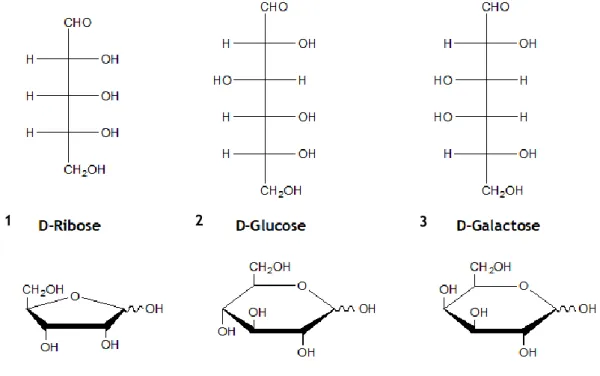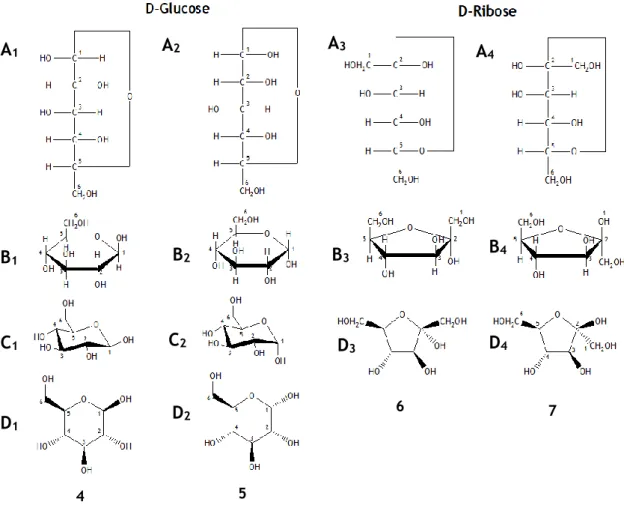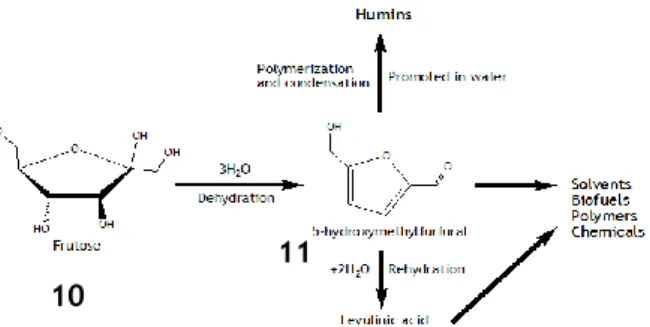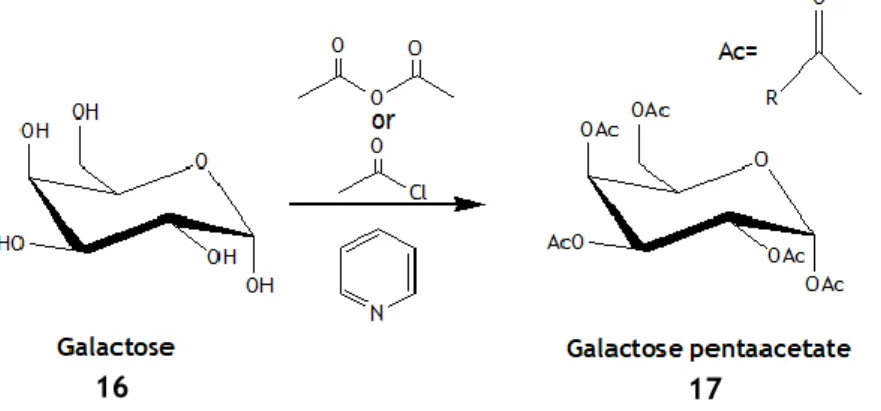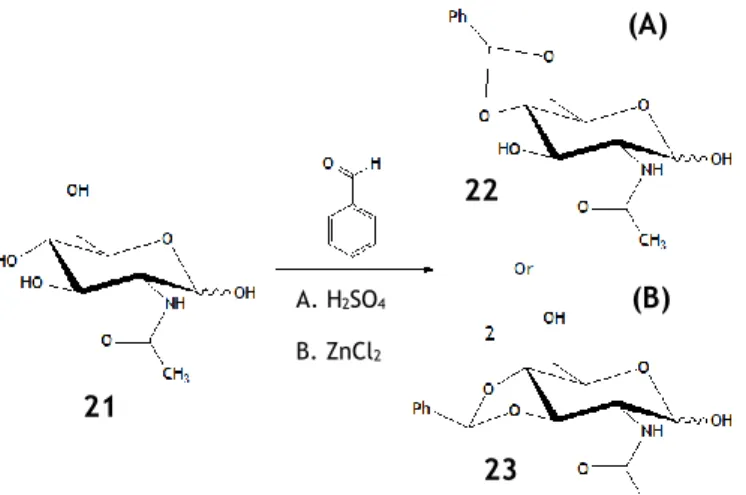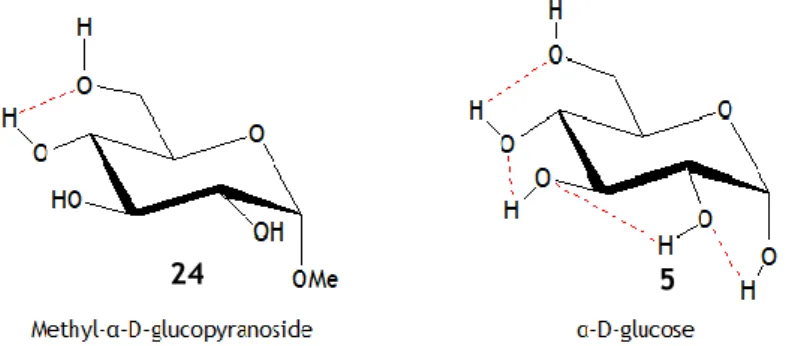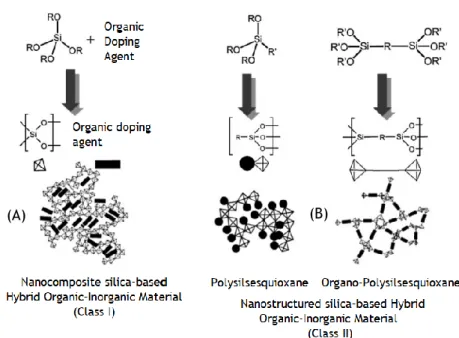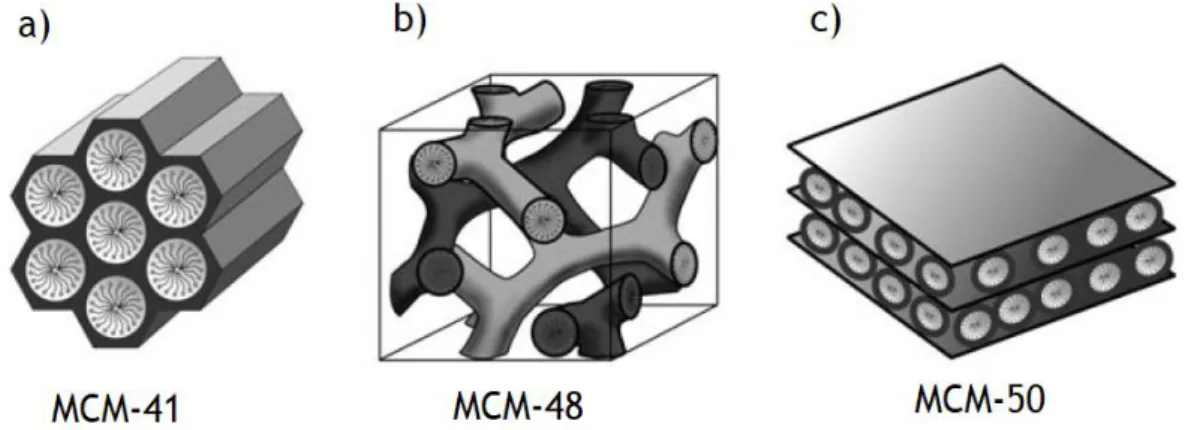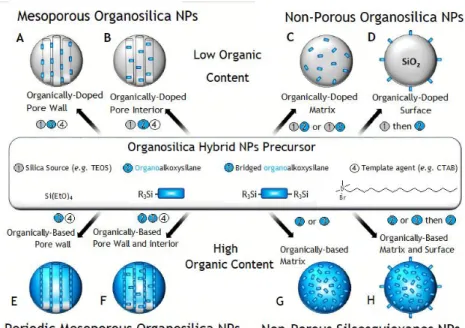UNIVERSIDADE DA BEIRA INTERIOR
Faculdade de Ciências
Functionalization and characterization of
carbohydrates for organotriethoxysilane
precursors’ synthesis
(Versão final após defesa)
Rodrigo Gabriel Rodrigues Pacheco
Dissertação para obtenção do Grau de Mestre em
Química Medicinal
(2º ciclo de estudos)
Orientador: Professora Doutora Maria Isabel Guerreiro da Costa Ismael Coorientador: Professora Doutora Sílvia Cristina Cláudio Nunes
Acknowledgements
This presented work has been performed at the Department of Chemistry, University of Beira Interior, in the synthesis and structural characterization laboratory, between September 2016 and January 2019. During this time, many contributed for this achievement, physically and psychologically.
Before all else, would like to thank my parents, without them, would be impossible to walk this long course. Never giving up on me, they encouraged me to continue this arduous path, making me believe in myself.
I would like to thank my thesis advisor Ph.D. Maria Isabel Guerreiro da Costa Ismael and co-advisor Ph.D. Silvia Cristina Cláudio Nunes for all the support and patience in all this way. Also, I would like to thank Ph.D. José Albertino Almeida de Figueiredo for all support and availability throughout this work. Especially thankful for all the knowledge shared, and all the never-ending support from all my family and friends.
Could never rightfully thank to all people who helped me and gave me motivation to surpass this task in the most arduous moments. To all, the biggest appreciation for all the support.
Resumo alargado
Os hidratos de carbono estão presentes em todos os organismos vivos e plantas, desempenhando um papel fundamental em vários processos biológicos necessários à sua sobrevivência. Posto isto, é de extrema importância o seu estudo e o desenvolvimento de novas aplicações biomédicas baseadas neles. Devido as suas fantásticas características e versatilidade, estes têm sido utilizados no desenvolvimento de sistemas de entrega de fármacos, especialmente no tratamento do cancro, que apesar do estudo intensivo, continua a ser uma das maiores causas de mortes no mundo.
Com os avanços no estudo dos hidratos de carbono, cada vez mais derivados têm sido desenvolvidos, possibilitando a sua combinação com nano-estruturas, formando sistemas com aplicabilidades em inúmeras áreas como a química, engenharia, biologia, medicina, e muitas outras. Através desta sinergia é possível ultrapassar muitos problemas, ambientais e médicos, atualmente existentes.
Apesar das inúmeras possibilidades de nano estruturas, algumas têm sofrido principal atenção. Como exemplo temos as estruturas mesoporosas, com aplicações em áreas como cromatografia e de sensores, que nos últimos anos têm sido extensivamente estudadas e aplicadas em diversas áreas. Concomitantemente com este trabalho, temos os materiais mesoporosos de sílica. Tendo sido descobertos há relativamente pouco tempo, estes materiais têm sido intensivamente estudados de forma a desenvolver materiais cada vez mais organizados, com porosidades e estruturas cada vez mais definidas. Ao longo do seu desenvolvimento, estes materiais possibilitaram o encapsulamento de moléculas orgânicas à matriz inorgânica. Com esta combinação de compostos orgânicos e inorgânicos, surgiram os materiais ordenados mesoporosos de organosilica, e posteriormente os materiais periódicos mesoporosos de organosilica. Esta combinação, resulta numa sinergia entre as componentes orgânicas e inorgânicas, melhorando as características de ambas.
Juntando todo este conhecimento recentemente desenvolvido, sobre estruturas mesoporosas, com a quase infinita versatilidade dos hidratos de carbono, temos o principal objetivo deste trabalho: o desenvolvimento de precursores organossilanos, para posterior utilização no desenvolvimento de estruturas mesoporosas organizadas baseados em hidratos de carbono. Neste trabalho, algumas funcionalizações de açucares irão ser abordadas, com o principal objetivo de proteger os grupos hidroxilo presentes nos açucares, melhorando a sua solubilidade nos solventes orgânicos e permitindo uma ligação regiosseletiva ao material silicioso (isocianato de propil-trietoxisilano (ICPTES)), através de uma ligação uretano.
Este trabalho divide-se em duas fases. Na primeira foram preparados derivados de glúcidos, através da modificação dos grupos funcionais. Na segunda foram sintetizados precursores organossilanos, com base nos derivados e no composto silicioso isocianato de propil-trietoxisilano.
A primeira fase começa pela funcionalização do composto comercialmente disponível 1,2:5,6-di-O-isopropilideno-α-glucofuranose. Esta funcionalização consiste numa benzilação do hidroxilo na posição 3, na desproteção seletiva do grupo isopropilideno, seguida de uma oxidação dos dióis vicinais, e uma posterior redução do aldeído. Seguidamente realizou-se a funcionalização da D-ribose através de uma síntese de um só passo, onde ocorre a metilação da posição 1 e a formação de um grupo isopropilideno na posição 2 e 3. Seguidamente foi funcionalizada a N-acetilglucosamina através da metilação da posição 1 e da adição de um grupo benzilideno na posição 3 e 4. A síntese de derivados de glúcidos dá-se por terminada com a funcionalização da D-glucose, que foi feita através da benzilação dos grupos hidroxilos, seguida da acetilação seletiva da posição 6, e respetiva desacetilação da mesma posição, resultando num grupo hidroxilo desprotegido.
Seguidamente foi realizada a síntese dos precursores organossilanos, para os quais foram utilizados os anteriormente referidos derivados de glúcidos, bem como os comercialmente disponíveis 1,2:5,6-di-O-isopropilideno-α-D-glucofuranose, 1,2-O-Isopropilideno-α-
D-xilofuranose, e 2,3,4,6-tetra-O-benzil-α-D-glucopiranose. Esta síntese baseou-se na formação de uma ligação uretano entre os derivados de glúcidos e o isocianato de propil-trietoxisilano. A síntese e caracterização dos compostos e precursores foi acompanhada pela análise através de ressonância magnética nuclear de carbono e protão, comprovando a sua estrutura, e a reação de formação dos precursores foi controlada por espetroscopia de infravermelho. Com este trabalho, realizou-se a combinação entre materiais siliciosos e hidratos de carbono, uma combinação inovadora com muito potencial de desenvolvimento e inúmeras aplicabilidades.
Palavras-chave
Derivados de glúcidos, materiais mesoporosos, precursores organossilanos, materiais híbridos, sistemas de entrega de fármacos.
Abstract
Carbohydrates are ubiquitous in all living beings, from the most complex – the humans – to the unicellular organisms. Fundamental in all kinds of biological processes, carbohydrates represent expedient candidates for biomedical applications. Through their use, countless barriers could be overcome, especially the lack of selectivity on cancer’s treatment. Although their advantages, carbohydrate synthesis is still far from completely unearthed and understood. However, the growing necessities thrust the field to more complex subjects, leading to the discovery of new potent devices capable of overwhelming the field of medicine.
The same driving force pushed the field of nanotechnology to the development of new materials, with applicabilities in uncountable fields. One of these materials was the mesoporous materials, which were recently discovered, and gain major focus of research in past years. This research flows towards the creation of materials progressively more complex and organized, ultimately leading to periodic mesoporous materials. These materials can be packed with organic moieties, leading to a synergetic combination between the organic and the inorganic features.
This combination conducted to the objective of this work, which can be divided in two phases. The first is synthesis of glycoside derivatives, through their functionalization, for posterior linkage to a siliceous material - in phase two - resulting in mono/di-organosilane precursors, which can be used to prepared mesoporous materials – ordered or periodic. The use of carbohydrate derivatives in combination with these materials is an innovative field, with scarce research carried, and since the synergetic combination of the organic/inorganic features, is a promising field for the development of more efficient biomedical devices, for example, drug delivery systems.
Keywords
Index
Acknowledgements ... v
Resumo alargado ...vii_Toc15552349 Abstract... ix
Index ... xi
Figure Index ... xv
Scheme Index ... xvii
Graphic Index ... xix
Table Index ... xxi
Acronym list ... xxiii
1. Introduction ... 1
1.1. A brief introduction to carbohydrates ... 2
1.2. Synthesis of glycosides ... 5
1.2.1. General reactions ... 5
1.2.1.1. Hydroxyl group’s protection ... 9
1.2.2. Carbohydrates’ stereoselectivity ... 12
1.3. A brief introduction to glyconanotechnology ... 16
1.3.1. Synthesis of Glyconanosystems... 17
1.3.2. Hybrid materials ... 18
1.4. Mesoporous materials ... 20
1.4.1. Mechanisms of Ordered Mesoporous Materials ... 23
1.4.1.1. Sol-gel process ... 25
1.4.2. Organo-functionalization of mesoporous materials ... 27
1.4.3. Periodic mesoporous organosilica ... 28
1.4.4. Organosilane precursors ... 31
1.4.5. Glyconanotechnology applications ... 31
2. Aims... 35
3. Discussion and results ... 37
3.1. Synthesis of glycoside derivates ... 37
3.1.1. Synthesis of the 3-O-benzyl-1,2-O-isopropylidene--D-gluco-pentodialdo-1,4-furanose (46) ... 37
3.1.1.1. Benzylation ... 38
3.1.1.2. Selective deprotection of C5,6 hydroxyl groups ... 38
3.1.1.4. Aldehyde reduction ... 38
3.1.2. Synthesis of the 1-O-Methoxy-2,3-O-isopropylidene-β-D-ribofuranose (47) ... 39
3.1.3. Synthesis of the 1-O-methyl-2-N-acetylamido-4,6-O-benzylidene-2-deoxy-α-D-glucopyranoside (50) ... 40
3.1.3.1. Methylation ... 40
3.1.3.2. Benzylidene addition ... 40
3.1.4. Synthesis of the 1,2,3,4-tetra-O-benzyl-α-D-glucopyranoside (53) ... 41
3.1.4.1. Benzylation ... 41
3.1.4.2. Acetylation ... 41
3.1.4.3. Selective deacetylation ... 42
3.2. Synthesis of mono-organosilane precursors ... 42
3.2.1. 6-O-methyl(3-(triethoxysilyl)propyl)carbamate-1,2,3,4-tetra-O-benzyl-α-D-glucopyranoside (55) ... 43 3.2.2. 3-O-Methyl(3-(triethoxysilyl)propyl) carbamate-1,2:5,6-di-O-isopropylidene-α– D-glucofuranose (56) ... 45 3.2.3. 5-O-Methyl(3-(triethoxysilyl)propyl)carbamate-1-O-methoxy-2,3-isopropylidene β–D-ribofuranose (57)... 47 3.2.4. 3-O-Methyl(3-(triethoxysilyl)propyl)carbamate-1-O-methoxy-2-N-acetamido-4,6-O-benzilidene-2-deoxy-D-glucopyranoside (58) ... 48 3.2.5. Bis(3,5-O-Methyl(3-(triethoxysilyl)propyl)carbamate-1,2-O-isopropylidene-α–D-glucofuranose (59) ... 50 3.2.6. 1-O-Methyl(3-(triethoxysilyl)propyl)carbamate-2,3,4,6-O-benzyl-D-glucopyranoside (60) ... 52
4. Conclusions and future work ... 55
5. Experimental section ... 57
5.1. General methods ... 57
5.2. Synthesis of glycoside derivates ... 58
5.2.1. Preparation of 3-O-benzyl-5-hydroxyl-1,2-O-isopropylidene--D-glucofuranose (46) ... 58 5.2.1.1. 3-O-Benzyl-1,2:5,6-di-O-isopropylidene-α-D-glucofuranose (43) ... 58 5.2.1.2. 3-O-benzyl-1,2-O-isopropylidene-α-D-glucofuranose (44) ... 59 5.2.1.3. 3-O-benzil-1,2-O-isopropilideno-α-D-xylo-pentodialdo-1,4-furanose ... 60 5.2.1.4. 3-O-benzyl-5-hydroxyl-1,2-O-isopropylidene--D-glucofuranose (46) ... 60 5.2.2. Preparation of Methyl-2,3-O-isopropylidene-α-D-ribofuranoside (47) ... 61
5.2.2.1. Methanol/Acetone/H2SO4 method (A)70 ... 61
5.2.2.2. Methanol/Acetone/H2SO4/ CuSO4 method (B)71 ... 61
5.2.3. Preparation of 1-O-methyl 2-N-acetylamido-4,6-O-benzylidene-2-deoxy-β-D-glucopyranoside (50) ... 62
5.2.3.2. 1-O-Methyl 2-N-acetylamido-4,6-O-benzylidene-2-deoxy-β-D-glucopyranoside ... 63 5.2.4. Preparation of 2,3,4-tri-O-benzyl-α-D-glucopyranoside (53) ... 63 5.2.4.1. 1,2,3,4,6-penta-O-benzyl-α-D-glucopyranoside (51) ... 63 5.2.4.2. 6-O-acetyl-1,2,3,4-tetra-O-benzyl-α-D-glucopyranoside (52) ... 64 5.2.4.3. 1,2,3,4-tetra-O-benzyl-α-D-glucopyranoside (53) ... 65
5.3. General procedure for synthesis of organosilane precursors ... 66
5.3.1. Mono-silylated precursors76 ... 66
5.3.1.1. 6-O-methyl(3-(triethoxysilyl)propyl)carbamate-1,2,3,4-tetra-O-benzyl-α-D-glucopyranoside (55) ... 67
5.3.1.2. 3-O-Methyl(3-(triethoxysilyl) propyl) carbamate-1,2:5,6-di-O-isopropylidene-–D-glucofuranose (56) ... 68 5.3.1.3. 5-O-Methyl(3-(trietoxysilyl)propyl)carbamate-1-O-methoxy-2,3-isopropylidene β–D-ribofuranose (57) ... 69 5.3.1.4. 3-O-Methyl(3-(triethoxysilyl)propyl)carbamate-1-O-methoxy-2-N-acetamido-4,6-O-benzilidene-2-deoxy-D-glucopyranoside (58) ... 70 5.3.1.5. 1-O-Methyl(3-(triethoxysilyl)propyl)carbamate-2,3,4,6-O-benzyl-D-glucopyranoside (60) ... 71 5.3.2. Bi-silylated precursors 76 ... 72 5.3.2.1. Bis(3,5-O-Methyl(3-(triethoxysilyl)propyl)carbamate-1,2-O-isopropylidene-α– D-glucofuranose (59) ... 72 6. References ... 73 7. Attachments ... 79
Figure Index
Figure 1 - Demonstration of the aldopentoses and aldohexoses (top), and respective hemiacetal (bottom). On the left we have D-ribose 1 with the aldopentose on top, and directly under the respective hemiacetal (furanose). On the center and right, is D-glucose 2 and D-galactose 3, with the aldohexose on top, and right under is the corresponding
hemiacetal (pyranose). ... 3 Figure 2 - Demonstration of Fisher’s, Haworth’s, and the “chair’s” projections. (A) represents the Fisher’s projection. (B) the Haworth’s projection. (C) is the “chair” conformation. In addition (D), represents the planar projection of all the represented carbohydrates. The sugars represented correspond to α-D-glucose (4), glucose (5), α-D-fructose (6), and β-D-fructose (7). ... 4 Figure 3 - Example of isomerization reaction, also known as Lobry de Bruyn-van Ekenstein rearrangement.16 ... 7
Figure 4 – Acylation reaction of Galactose (α-anomer on the example) using acetic anhydride or acetyl chloride, in anhydrous pyridine. ... 9 Figure 5 – Hydroxyl protection with an acetal group in D-ribose, resulting in a 1,3-dioxolane type group or an isopropylidene group. ... 11 Figure 6 – Example of hydroxyl group protection with a benzylidene group. In this example, two synthetic routes are approached, both using benzaldehyde as solvent. In the first (A) the H2SO4 is used as catalyst, stereoselectivily attacking the hydroxyls in the C4 and C6 positions.
In the second route (B), the ZnCl2 is used as catalyst resulting in the benzylation of the C3 and
C4 positions, respectively leading to 4,6-O-benzylidene-n-acetylglucosamine and
3,4-O-benzylidene-n-acetylglucosamine. ... 11 Figure 7 - Hydrogen bond network of methyl α-D-glucopyranose and the α-anomer of glucose, proposed by Davies.18 ... 15
Figure 8 - Sol-gel mechanisms to organic–inorganic hybrids based on polysilsesquioxanes matrices of class I or II. Figure adapted from bibliography.36 ... 19
Figure 9 - From left to right they are categorized in 2D hexagonal, body-centered cubic, face-centered cubic, and gyroid structures.40 ... 20
Figure 10 - schematic representation of three different mesophases, MCM-41, MCM-48, and MCM-50. The hexagonal phase possesses highly regular arrays of uniform-sized cylindrical mesopores, being the most stable and uniform.42,45... 21
Figure 11– General mechanisms of mesoporous silicas. On this scheme is represented the mechanisms of synthesis of porous (A, B, E, F)/non-porous (C, D, G, H) non-organized (C, D, G, H), ordered (A, B) or periodic (E, F) mesoporous organosilica materials.46 ... 23
Figure 12 - Representation of the hard-templating method for the synthesis of ordered mesoporous materials or isolated nanowires. This method is divided in three steps: Step 1 - Infiltration of the precursor inside the mesochannels of the silica template; Step 2 -
Conversion of the precursor in the mesochannels; Step 3 - Removal of the mesoporous silica templates or nanocasting.14 ... 25
Figure 13 – Functionalization of siliceous mesoporous through three different approaches resulting in three different hybrid materials. (A) Post-synthetic grafting, or indirect synthesis, consists in a two-step procedure, where initially the siliceous matrix is produced to be posteriorly grafted with the organosilane precursors. (B) Direct/one-pot synthesis, consists in the co-condensation of tetraalkoxysilanes [(RO)4Si (TEOS)] with terminal
(SDA) conducting to materials with organic residues anchored covalently to the pore walls. (C) Through the use of bridged organosilane precursors, periodic mesoporous materials are obtained, in which the organic moiety is internalized in the pore’s walls. Image adapted from
the bibliography.45 ... 28
Figure 14 - General synthetic pathway to PMOs using bissilylated organic bridging units. R= organic bridge. Figure adapted from bibliography.45... 29
Figure 15 – General representation of silsesquioxane (A), mono-organosilane (B), bissilylated (C) precursors, for the synthesis of mesoporous silicas (MSs), OMOs, and PMOs, respectively.54,57,58 ... 31
Figure 16 – Structure of precursor 55. Yield: 92% ... 67
Figure 17 – Structure of precursor 56. Yield: 93% ... 68
Figure 18 – Structure of precursor 57. Yield: 68% ... 69
Figure 19 – Structure of precursor 58. Yield: 89% ... 70
Figure 20 – Structure of precursor 60. Yield: 88% ... 71
Scheme Index
Scheme 1 – Hydrolysis reaction of disaccharide α-D-glucopyranosyl-β-D-frutofuranoside (8) (sucrose), by means of sucrase enzyme, resulting in two isolated monosaccharides, α-D-glucose (5) and β-D-fructose (9).16 ... 6
Scheme 2 - Example of dehydration reaction on fructose. This is an important reaction to synthesize 5-hydroxymethylfurfural (HMF), used in the production of many other substances, such as levulinic acid and humins. ... 7 Scheme 4 - Biochemical oxidation of β-D-glucose to D-glucono-1,5-lactone by glucose oxidase and subsequent hydration to gluconic acid. Catalase enzyme degrades the hydrogen peroxide formed during glucose oxidation. ... 8 Scheme 5 – Example of the per-O-acetylated glucose synthesis and subsequent anomeric bromination. As referred the one-pot synthesis leads to the synthesis of both 2,3,4,6-tetra-O-acetyl-α-D-glucopyranosyl and the benzoylated analogues. 16 ... 10
Scheme 6 - (A) Benzoylation of methyl-α-D-glucopyranoside, yielding two different products in two different ratios. (B) Carbon numbering according to how reactive each hydroxyl was under benzoylation conditions.18,32 ... 12
Scheme 7 – Representation of the intramolecular hydrogen bond network of four different monosaccharide derivates. (A) glucose; (B) altrose; (C1,2) galactose; (D) mannose; The
intramolecular network was determined by Vasella et al. and helped understand the
stereoselectivity in the studied monosaccharides.18 ... 13
Scheme 8 - (A) Methods for regioselective methylation of methyl α-D-mannopyranoside under conditions reported by Haworth et al., Kuhn et al., and Hakamori, and simultaneous
comparison of the synthetic route’s’ product ratio. (B) Methods for regioselective methylation of methyl β-D-xylopyranose using conditions reported by Haworth et al., Kuhn et al., Purdie et al., and Hakamori, and simultaneous comparison of the respective regioselectivity.18 .... 14
Scheme 9 – Schematic representation of template-directed synthesis. In the image we can observe: (A) surfactant molecules in solution, starting aggregation form (B) surfactant
micelles, and subsequently (C) the nanorods that will serve as template for the nanocasting of (D) the mesoporous material. ... 24 Scheme 10 – Representation of the chemical reactions on the classical sol-gel polymerization. ... 26 Scheme 11 – Schematic representation of the different stages and processes of the sol-gel technique. Image adapted from bibliography.46,47 ... 26
Scheme 12 - Synthetic pathway to obtain compound 46. Conditions and yield: a) BnBr, NaH/DMF, r.t., 20 min, 93%; b) AcOH 80%, 1h, 60ºC, 89%; c) 1.EtOH 2.NaIO4/H2O, 20 min,
96%; d) NaBH4/EtOH 70%, 1h, 0ºC, 89%. ... 38
Scheme 13 – One-pot synthesis of the D-Ribose derivate 47. Conditions and yield: a) Acetone, methanol, CuSO4, r.t., 48h, 90%.71,72 ... 39
Scheme 14 – Synthetic path of compound 50. Conditions and yield: a) Acetyl chloride, anhydrous methanol, r.t., 5h, 62%; b) Benzaldehyde, zinc chloride, r.t., 4h, 58%. ... 40 Scheme 15 – Synthetic path for the synthesis of compound 53. Conditions and yield: a) 1.DMF/NaH 2.BnBr, r.t., O.N., 61%; b) ZnCl2/1:5 HOAc-Ac2O, r.t., 1.5h, 95%; c) MeOH/NaOMe,
r.t., 5h, 79%. ... 41 Scheme 16 - Synthesis of carbohydrate-based organosilane precursors. The conditions were the same76 for all precursors (THF, 55ºC~60ºC), only differing on the reaction time which was
controlled by FTIR. Glycoside, reaction time and yields: a) 53, 8 days, 92%; b) 42, 12 days, 93%; c) 47, 6 days, 68%; d) 50, 12 days, 89%; e) 61, 7 days, 71%; f) 62, 12 days, 88%. ... 43 Scheme 17– Synthetic route76 to prepare de precursor 55. Conditions and yield: THF, 60ºC, 8
days, 92%. ... 43 Scheme 18 - Synthetic route76 to prepare de precursor 56. Conditions and yield: THF, 60ºC,
12 days, 93%. ... 45 Scheme 19 - Synthetic route76 to prepare de precursor 57. Conditions and yield: THF, 60ºC, 6
days, 68%. ... 47 Scheme 20 - Synthetic route76 to prepare de precursor 58. Conditions and yield: THF, 60ºC,
12 days, 89%. ... 48 Scheme 21 - Synthetic route76 to prepare de precursor 59. Conditions and yield: THF, 60ºC, 7
days, 71%. ... 50 Scheme 22 - Synthetic route76 to prepare de precursor 60. Conditions and yield: THF, 60ºC,
12 days, 88%. ... 52 Scheme 23 – Reaction of 42 to obtain 43. Yield: 92%. ... 58 Scheme 24 - Schematic representation of the synthesis of compound 44. Yield: 88% ... 59 Scheme 25 – Schematic representation of compound 44 reaction to form compound 45. Yield: 96% ... 60 Scheme 26 – Schematic representation of the reactional formation of compound 46. Yield: 89% ... 60 Scheme 27 – Schematic representation of two synthetic approaches (A and B) for the
production of compound 47. (A) Yield: n.a. (B) Yield: 90% ... 61 Scheme 28 – Schematic representation of the first reaction to synthesize compound 49 from commercially available compound 48. Yield: 61% ... 62 Scheme 29 – Schematic representation of the second reaction of compound’s 50 synthesis. Yield: 58% ... 63 Scheme 30 – Schematic representation of the synthetic approach used to produce compound 51 from commercially available 5. Yield: 61% ... 63 Scheme 31 – Schematic representation of the synthetic formation of compound 52. Yield: 95% ... 64 Scheme 32 – Schematic representation of the synthetic path to produce compound 53. Yield: 79% ... 65 Scheme 33 – General procedure for the synthesis of organosilane precursors, through the functionalized carbohydrate-derivates 42, 47, 50, 53, 61, and 62, reaction with ICPTES 54. ... 66
Graphic Index
Graphic 1 – Contrast between the reaction FTIR spectrum at day 0 (A) and day 8 (B). Through this comparison is possible to notice the disappearing of the band associated to isocyanate group at 2271 cm-1. ... 44
Graphic 2 - Contrast between the reaction FTIR spectrum at day 0 (A) and day 12 (B). Through this comparison is possible to notice the disappearing of the band associated to isocyanate group at 2271 cm-1. ... 46
Graphic 3 – Contrast between the reaction FTIR spectrum at day 0 (A) and day 6 (B). Through this comparison is possible to notice the disappearing of the band associated to isocyanate group at 2272 cm-1. ... 47
Graphic 4 – Contrast between the reaction FTIR spectrum at day 0 (A) and day 6 (B). Through this comparison is possible to notice the disappearing of the band associated to isocyanate group at 2271 cm-1. ... 49
Graphic 5 – Contrast between the reaction’s FTIR spectrum at day 0 (A) and day 7 (B). Through this comparison is possible to notice the disappearing of the band associated to isocyanate group at 2271 cm-1. ... 51
Graphic 6 – Contrast between the reaction’s FTIR spectrum at day 0 (A) and day 12 (B). Through this comparison is possible to notice the disappearing of the band associated to isocyanate group at 2271 cm-1. ... 52
Table Index
Table 1 – 13C-NMR and 1H-NMR spectrum data of compound
Methyl-2,3-O-isopropylidene-β-D-ribofuranoside 47 in comparison to α-D-ribose 7. ... 39
Table 2 – 13C NMR data of compound 53, in comparison with the bibliography data of compound 52. ... 42
Table 3 – 1H NMR data of compound 53, in comparison with the bibliography data of compound 52. ... 42
Table 4 - 1H-NMR spectra data of glycoside 55. ... 44
Table 5 – 13C-NMR spectra data of glycoside 55. ... 45
Table 6 - 13C-NMR spectra data from compound 56. ... 46
Table 7 - 1H-NMR spectra data from compound 56. ... 46
Table 8 - 1H-NMR data of precursor 57 in comparison with the data of compound 47. ... 48
Table 9 - 13C-NMR data of precursor 57 in comparison with the data of compound 47. ... 48
Table 10 - 1H-NMR data of precursor 58. ... 50
Table 11 - 13C-NMR data of precursor 58. ... 50
Table 12 - 1H-NMR data from precursor 59. ... 51
Table 13 - 13C-NMR data from precursor 59. ... 51
Table 14 - 1H-NMR data from precursor 60. ... 53
Acronym list
μm Micrometre
Å Angström
λ Lambda
Ac2O Anhydride acetic
AcCh Acetyl chloride
AcOH Acetic acid
AM1 Austin model 1
ATR Attenuated total reflectance
BnBr Benzyl bromide
cm Centimetre
DAG Di-acetone-D-Glucose
DCM Dichloromethane
DDS Drug delivery system DMAP 4-(dimethylamino) pyridine
DMF Dimethylformamide
DMSO Dimethyl sulfoxide
DMSO-d6 Deuterated dimethyl sulfoxide
DNA Deoxyribonucleic acid
DRIFTS Diffuse reflectance infrared Fourier transform spectroscopy
EA Element analysis
EISA Evaporation induced self-assembly
EtOH Ethanol
FT-IR Fourier-transform infrared
g Grams
GNP Glyconanoparticle
HMF 5-hydroxymethylfurfural
ICPTES 3-(Triethoxysilyl)propyl isocyanate
IUPAC International union of pure applied chemistry LCT Liquid-crystal templating
mbar Millibar
MeOH Methanol
MHz Mega hertz
mm millimeter
mmol Millimole
MS Mesoporous silica
n.a. Not applicable
NaOMe Sodium methoxide
n.d. Not defined
nm Nanometer
NMR Nuclear magnetic resonance spectroscopy OMO Ordered mesoporous organosilica
OMS Ordered mesoporous silica
O.N. Over night
overl. overlapping
PEO Poly(ethylene oxide)
PMO Periodic mesoporous organosilica PMS Periodic mesoporous silica PSD Pore size distribution
R.f. Retention factor
r.t. Room temperature
SDA Structure directing agent SEM Scanning electron microscopy TEM Transmission electron microscopy TEOS Tetraethyl orthosilicate
TGA Thermo gravimetric analysis
THF Tetrahydrofuran
TLC Thin layer chromatography
TMS Tetramethylsilane
1. Introduction
Carbohydrates are ubiquitous in all living beings1, although the importance of their existence,
such as in reproduction, inflammation, signal transmission and infection2, the development of
medical tools based on these biomolecules3 is of increasing importance. The biocompatibility
of the carbohydrates, and their ability to be recognized by cell-surface receptors denote their potential for therapeutic applications.2,4,5,6
This major class of naturally occurring organic compounds, gained their designation due to their general formula Cn(H2O)m with n equal to or greater than three, which means that
carbon is bonded to water molecules forming “hydrates of carbon”. Nevertheless, many derivatives of carbohydrates exist with other components in their structure. Therefore the formula should not be used as a carbohydrate general formula. Among them are various sugars, starches, and cellulose, all of which are important for the maintenance of life in both plants and animals.7
Due to the increased attention on the subject, and the advances inherent to it, is now possible to overcome the problems on the synthesis of carbohydrates that existed a few decades ago.2 These group of biomolecules exhibits innumerous biomedical applications, and
have recently being used and researched - as glyconanosystems - for the development of carbohydrate-mimetic diagnostics and drug candidates.2,8
Attributable to their versatility, the development and research in the area is of extreme importance. Carbohydrate can be used in uncountable medical applications–such as vaccines, drug delivery systems (DDS), and some more that will be briefly summarized in this work. With this increased research in the field, more commonly the term glycoscience - i.e., the group of disciplines that study carbohydrates and their interactions with biomacromolecules and intrinsic biological processes - has been applied.2 The advances in glycoscience enabled a
new specter of applications thrusted by all information acquired with the past research years. One of the focus is the development of anti-cancer DDS.
Hence its complexity, cancer has more than one hundred different types, and besides all the effort and research in the area, still has high rates of mortality and occurrence9. It is
characterized by uncontrollable cell growth and dissemination of malignant cells.9,10 The
common treatments are the conventional therapies - using chemotherapy as main resource, bringing many undesirable effects attached. These side effects are mainly caused by the lack of selectivity of the chemotherapeutic agents, causing damage to the normal cells.11
The use of carbohydrates enables a wide number of possibilities to overcome the selectivity problems, using the glycosidic receptors, and their interactions to selectively attack the
malign cells. Adding all this know-how with the advances in the development of more complex and precise DDS, is nowadays possible to do a more accurate drug delivery, enhancing the selectivity and efficiency of the treatments. Furthermore, there always have been difficulty in trespassing biological barriers.12
In the last years, the ever-growing necessities of engineering, chemistry, materials science, and biology strongly encouraged the development of novel porous materials with more tunable features,13–15ranging from nanoparticles, polymers, hydrogels, and hybrid materials.
In this latter mentioned class, also known as nanocomposites, the combination of organic and inorganic moieties is achieved in a synergetic way. One of the most attractive materials in this class is the silica-based mesostructures. These materials, with applicabilities in many areas, leaded to the development of increasingly more organized materials, starting with ordered mesoporous organosilicas (OMOs) and ultimately leading to the discovery of the periodic mesoporous organosilicas (PMOs).
Through these materials is possible to overcome many existing barriers and is possible to synergistically combine them with the excellent features of carbohydrates, permitting their disposal in a multivalent fashion-way, creating synthetic “scaffolds” with varying valency and spatial organization. However for the production of these materials, first in necessary the preparation of organosilane precursors, where the organic part is covalently linked to the siliceous materials, which are posteriorly introduced in the inorganic matrices. The development of these precursors is of extreme importance and that was the thrusting force for the realization of the work herein presented.
1.1. A brief introduction to carbohydrates
Due to the long and awkward names, given by the IUPAC system, to the saccharides, a highly specialized nomenclature system has been developed exclusively for carbohydrates.7
Some of the most abundant five-carbon sugars are D-ribose, 2-deoxy-D-ribose, and D-xylose, which are aldopentoses. Some of the most common six-carbon sugars (hexoses) were studied on this work, such as D-glucose and n-acetylglucosamine, belonging to the aldohexose group.7
Figure 1 - Demonstration of the aldopentoses and aldohexoses (top), and respective hemiacetal
(bottom). On the left we have D-ribose 1 with the aldopentose on top, and directly under the respective hemiacetal (furanose). On the center and right, is D-glucose 2 and D-galactose 3, with the aldohexose on top, and right under is the corresponding hemiacetal (pyranose).
The name ‘monosaccharide’ denotes a single unit without any glycosidic connection. In chemical terms, they are either aldoses or ketoses, the ending ‘ose’ is the indicative suffix of a sugar.16 In the solid state or in solution monosaccharides exist in cyclic
hemiacetal/hemiketal form, ring closure correspondent to the reaction between the aldehyde or ketone group and either the C4-OH or C5-OH.7,16 Cyclization involving C4-OH results in a
five-carbon ring structurally related to furan and therefore designated as a furanose. The second cyclization, of O-5, gives rise to a six-membered ring - a strain-free hemiacetal - hence a sterically more favored derivate of pyran, henceforth termed as pyranose.16
Both ring formations generate a new asymmetric carbon atom at C1, anomeric center,
thereby giving rise to diastereomeric hemiacetals which are labeled α and β (figure 2).16
The understanding of the conformational concepts is essential to a proper understanding of the structure-property relationships of carbohydrates, especially for the regio-stereoselectivities of their reactions.7,16
Hence, the rhombus-shaped Haworth formulas which imply a planar ring, and the equally flat dashed-wedged line configurational depictions by Mills are inadequate to represent the actual three-dimensional shape of the rings and the steric orientation of the ring substituents (OH and CH2OH groups), thus they still are the preferred way of drawing furanose forms. For the
six-membered pyranose ring several recognized conformers exist: two chairs, six boats, six skews and twelve half-chairs (figure 2).16,17
Although the exceptions, most aldohexoses adopt the chair conformation that places the bulky hydroxymethyl group at the C-5 terminus in the equatorial position, especially the 4C
1
chair conformation that is energetically more favored than the 1C
4 conformation.16
Through the glycosidic linkages between monosaccharide unites, the oligosaccharides are formed - i.e., simple polymers containing between two or ten monosaccharide residues. The oligosaccharides can be either homo- (consisting of only one type of monosaccharide) or hetero-oligosaccharide.16
Figure 2 - Demonstration of Fisher’s, Haworth’s, and the “chair’s” projections. (A) represents the
Fisher’s projection. (B) the Haworth’s projection. (C) is the “chair” conformation. In addition (D), represents the planar projection of all the represented carbohydrates. The sugars represented correspond to α-D-glucose (4), β-D-glucose (5), α-D-fructose (6), and β-D-fructose (7).
Due to all the complexity of the subject in study, I though a brief introduction was needed to a further understanding of the thesis content. Hence done, I will now demonstrate some of the most used synthesis paths and reaction methods on glycoscience.
A
4A
2A
1A
3B
1B
2B
3B
4C
1C
2D
1D
2D
3D
4 4 5 6 71.2. Synthesis of glycosides
Has previously said, the synthesis of carbohydrates weren´t always possible, neither their interaction mechanisms were known to permit their efficient application. However, through the past decades, advances in technology and knowledge opened new doors, allowing innumerous opportunities. A withstanding challenge in glycoscience is the regioselective monofunctionalization in addition to stereoselectivity (specifically, how to control whether α or β anomers form).
Selective protection of secondary hydroxyl groups of carbohydrate building blocks is significantly challenging. Chemists commonly use a series of protection and deprotection steps in processes that are wasteful, costly, time consuming and that, in the end, have low yields. One solution to the problem is to use enzymes - i.e., glycosyltransferases - to perform selective glycosylation reactions, but enzymes are very substrate specific and their application to large industrial scale is often difficult.18 With so, further investigation on the
field is of major importance, to a better understanding of the interactions between carbohydrates and biomolecules, and themselves.
1.2.1. General reactions
Only the relative reactions and mechanisms will be discussed in this chapter, since the reaction possibilities with carbohydrates are enormous.
Carbohydrates are polyfunctionalized compounds that contain primary and secondary hydroxyl groups differing in terms of reactivity. Some chemical transformations of these functions have been exhaustively studied in the last years to permit the stereoselective functionalization of the hydroxyl groups.19 Some of those transformations are thereby shown
and explained in this part.
Since the enormous reaction possibilities involving carbohydrates, only the reactions and mechanisms of interest will be discussed. However, some of the general carbohydrate-involving processes will be briefly attended for a clear and further understanding on the subject.
As referred, polysaccharides are formed by “chains” of many sugar units. For the separations of these “chains”, hydrolysis can be achieved through enzymes – i.e. glycosidases – or chemically – through acid treatments – for the release of the monosaccharide units.16
Scheme 1 – Hydrolysis reaction of disaccharide α-D-glucopyranosyl-β-D-frutofuranoside (8) (sucrose), by
means of sucrase enzyme, resulting in two isolated monosaccharides, α-D-glucose (5) and β-D-fructose (9).16
The enzymatic way proceeds with higher specificity towards both the sugar and the con- figuration at the anomeric center. The chemical way includes much more harsh conditions, like very acidic conditions and high temperatures.16
Using the chemical hydrolysis path is impossible to avoid the degradation of the sugar constituent – due to the harsh hydrolysis conditions. However, if this degradation is manipulated properly, it can be used to produce important chemicals. For example, when harsh acidic conditions are used, strong acids induce water elimination – i.e. dehydration - through this, the furfural’s production process can be achieved, as demonstrated in the scheme 2 with some other chemical’s process.16,20
8
Scheme 2 - Example of dehydration reaction on fructose. This is an important reaction to synthesize
5-hydroxymethylfurfural (HMF), used in the production of many other substances, such as levulinic acid and humins.
Since their low resistance to high temperatures, when exposed to them, carbohydrates also decompose/dehydrate, occurring the darkening – i.e. caramelization.16 When submitted to
basic condition, aldoses isomerize to their C-2 epimers and the respective ketoses. Through this, particular products can be prepared. For example, any of the three sugars, glucose, D-fructose, or D-mannose is converted into an equilibrium mixture containing D-glucose (57 %), D-fructose (28 %), and D-mannose (3 %), through mild basic conditions (figure 3).16
Figure 3 - Example of isomerization reaction, also known as Lobry de Bruyn-van Ekenstein
rearrangement.16
When in solution, sugars stablish an equilibrium between their pyranoid or furanoid hemiacetal forms through open-chain carbonyl species (scheme 3).16
2 12 10
13 10
Scheme 3 - Example of a carbonyl group reaction on glucose. Groups on the left side of Fisher projection are facing upwards, while groups on rigth side are facing downwards in Haworth’s projection.The species are in equilibrium between the two forms.16
One important process in the history of glycoscience is glycosidation. When mixed with alcohols in the presence of acid catalysts, reducing sugars give the respective full acetals, named glycosides – i.e., Fisher glycosidation.16,21 Forwardly, depending on the distribution of
the furanoid and pyranoid tautomeric form in the reaction mixture, not only glycosides with different ring sizes - i.e., glycopyranosides and glycofuranosides - can result, but also the corresponding α- and β-anomer. For example, when D-glucose is heated with methanol in the presence of anhydrous hydrogen chloride, pure crystalline methyl α-D-glucopyranoside can be isolated in 90% yield, whilst the same reaction with D-galactose yields a mixture of the two furanoid and pyranoid methyl galactosides, from which the methyl α-D-galactopyranoside can be obtained in crystalline form but in a much lower yield.16
Another important process is the oxidation. Like in hydrolysis, oxidation can be achieved enzymatically – in a controlled stoichiometric fashion through dehydrogenases or oxidases – or chemically – with bromine or iodine in buffered solutions. 16,22
Scheme 4 - Biochemical oxidation of β-D-glucose to D-glucono-1,5-lactone by glucose oxidase and
subsequent hydration to gluconic acid. Catalase enzyme degrades the hydrogen peroxide formed during glucose oxidation.
4 14
Forwardly, reactions of hydroxyl group’s protection will be analyzed, with a more intense focus on the reactions used in the experimental section of this thesis.
1.2.1.1. Hydroxyl group’s protection
The alcohol and phenol protection are one of the most frequently employed reactions in organic synthesis, and so in glycoscience.23 They are of extreme importance to the
construction of oligosaccharides and to the functionalization of the carbohydrates, and to the synthesis of glyconanoparticles and sugar-based materials.
o Acylation
The acylation of functional groups, especially hydroxyl and amino groups is one of the most basic and frequently used transformations in glycoscience, as it provides a useful and efficient protection protocol in a multistep synthetic process.24 Moreover, this reaction has a
biomimetic importance, as acylation of xenobiotics is a metabolic pathway that increases lipophilicity.24
This protection method is normally achieved through anhydrides or acyl chlorides in the presence of tertiary amine bases such as either triethylamine or pyridine, Lewis or protonic acids, or sometimes solid acid catalysts, in suitable, when necessary, organic solvent, although acetic anhydride is the most commonly used - being less toxic.23,24
Figure 4 – Acylation reaction of Galactose (α-anomer on the example) using acetic anhydride or acetyl
chloride, in anhydrous pyridine.
The rate of acylation in the basic conditions is known to be raised multifold if 4-(dimethylamino)pyridine (DMAP) is used as a cocatalyst.23,24 The most commonly used
solvents, for this functionalization, are methylene chloride, acetonitrile and tetrahydrofuran. The use of DMAP as catalyst exhibit a stereoselective effect on the reaction. DMAP and chiral DMAP derivatives are now commonly used as catalysts (catalytically or stoichiometrically) in many reactions, including peptide bond formation25, the Baylis-Hillman reaction26, and
Michael addition27. For carbohydrate chemists, DMAP-catalyzed acylation of alcohols
represents an essential tool to functionalize sugars. Through various studies, was clear that the stereochemistry at the anomeric position affected the reactivity of the hydroxyls and the outcome of acylation. Researchers also found position C4 to be nearly unreactive in the
absence of DMAP, proving that reactivity may also depend on the acylating agent used. The most commonly used solvents, for this functionalization, are methylene chloride, acetonitrile and tetrahydrofuran (THF). The use of toxic metal derivatives and chlorinated hydrocarbons as solvents, apart from operational disadvantages, do not satisfy the requirements of green synthesis. Thus, a practical, efficient and greener alternative is needed. For that, B. Ranu et al. explored a greener method, with no solvent or catalyst needed.24
o Acylated Glycosyl Halides
Glycosyl halides can be formed smoothly, dissolving per-O-acetylated monosaccharides in cold solutions of the hydrogen halide in glacial acetic acid. However, acetates from acid-sensitive oligosaccharides may undergo cleavage of glycosidic bonds.16,28,29
Because of the dominance of the anomeric effect in the pyranosyl cases, the anomer with axial halide is substantially preferred.16,21,30
Accordingly, on acylation and subsequent HBr-treatment, usually performed as a one-pot operation, D-glucose yields the 2,3,4,6-tetra-O-acetyl-α-D-glucopyranosyl or its benzoylated, pivaloylated analogues (scheme 5).16
Scheme 5 – Example of the per-O-acetylated glucose synthesis and subsequent anomeric bromination.
As referred the one-pot synthesis leads to the synthesis of both 2,3,4,6-tetra-O-acetyl-α-D-glucopyranosyl and the benzoylated analogues. 16
o Acetals
Normally produced from the reaction of an aldehyde or ketone — benzaldehyde and acetone being the most common — with a geometrically suitable diol grouping, of which there is a large variety in free sugars, glycosides, and alditols.16
These reactions are carried out in aldehyde or ketone as solvent with an electrophilic catalyst (H2SO4 or ZnCl2). The synthesis can be thermodynamically controlled and usually very specific,
under these conditions. Ketones such as acetone or cyclohexanone predominantly bridge vicinal diols to form five-membered cyclic products (1,3-dioxolanes) as exemplified by the O-isopropylidene derivative of D-Ribose (figure 5).
Figure 5 – Hydroxyl protection with an acetal group in D-ribose, resulting in a 1,3-dioxolane type group
or an isopropylidene group.
Aldehydes, however, show a distinct preference for 1,3-diols, as illustrated by the six-membered 4,6-O-benzylidene and 3,4-O-benzylidene acetals of n-acetylglucosamine (figure 6). 16
Figure 6 – Example of hydroxyl group protection with a benzylidene group. In this example, two
synthetic routes are approached, both using benzaldehyde as solvent. In the first (A) the H2SO4 is used
as catalyst, stereoselectivily attacking the hydroxyls in the C4 and C6 positions. In the second route (B),
the ZnCl2 is used as catalyst resulting in the benzylation of the C3 and C4 positions, respectively leading
to 4,6-O-benzylidene-n-acetylglucosamine and 3,4-O-benzylidene-n-acetylglucosamine.
1 20 21 22 23 (A) (B) A. H2SO4 B. ZnCl2
The introduction of cyclic acetal groups into sugars is quite satisfactory in terms of yields. As cyclic acetals are stable towards alkali, the entire repository of organic reactions requiring basic conditions can be applied.16
o Thioacetals
Sugars react rapidly with alkanethiols in the presence of acid catalysts at room temperature to give acyclic dialkyl dithioacetals as the main products31, and therefore the reaction is
markedly different from the Fischer glycosidation. These open-chain compounds can be used to prepare monosaccharide derivatives with a free carbonyl group and protected with acetyl groups in the other hydroxyl groups.16
1.2.2. Carbohydrates’ stereoselectivity
For a better understand of the reaction selectivity on a sugar, Williams and Richardson in 1967 first ranked the secondary hydroxyls of three sugars - methyl α-D-glucopyranoside, methyl α-D-mannopyranoside and methyl α-D-galactopyranoside - according to how reactive each hydroxyl was under benzoylation conditions (Scheme 6, image (B))18
Scheme 6 - (A) Benzoylation of methyl-α-D-glucopyranoside, yielding two different products in two
different ratios. (B) Carbon numbering according to how reactive each hydroxyl was under benzoylation conditions.18,32
Conclusively, the study revealed that the primary hydroxyl at position 6 of each sugar reacted first, demonstrating to be the most accessible of them all. The rest of the reactivity trends for secondary hydroxyls are the following: C2-OH>C3-OH>C4-OH for the glucopyranoside, C3
-OH>C2-OH>C4-OH for the mannopyranoside, and finally C2-OH, C3-OH>C4-OH for the
galactopyranoside.18 The theoretic proposition was that intramolecular hydrogen-bonding
possibly influenced the reactivity of each hydroxyl. While the adjacent anomeric position may contribute an extra hydrogen bond to the C2-OH, thereby increasing the reactivity of the C2
-(A) (B) 67% 28% 24 25 26 24 27
OH of the glucopyranoside, the C2-OH is axial in the mannopyranoside, rendering it less
reactive than the C3-OH.18
A few years later, Kondo et al. also demonstrated that the order of reactivity of the secondary hydroxyls of methyl 6-deoxy- α- and β-D-glucopyranosides was the same as the order that Williams and Richardson previously observed for methyl α- and β-D-glucopyranosides.33 Researchers demonstrated that hydroxyls of different sugars have
different intrinsic reactivity patterns that vary depending on the sugar explored (scheme 7).18
Scheme 7 – Representation of the intramolecular hydrogen bond network of four different
monosaccharide derivates. (A) glucose; (B) altrose; (C1,2) galactose; (D) mannose; The intramolecular
network was determined by Vasella et al. and helped understand the stereoselectivity in the studied monosaccharides.18
These studies revealed that the selectivity is highly dependent on the conditions (methylating agent and base) and substrate. The substrate used with Haworth and Hakamori’s conditions leads either to similar selectivities with methyl α-D-mannopyranoside or very different selectivities with methyl β-D-xylopyranoside (Scheme 7, A and B).18 One of the theoretic
propositions was that the relative acidities of the hydroxyl groups in methyl β-D-xylopyranoside is a major factor controlling the selectivity (Scheme 7, B).
(A) (B) (C1) (D) (C2) 28 29 30 31 32 33 34 35 36
All this research settles the stage for future work that could reveal whether extrinsic factors, such as the sterics of the reagent, also influence the products formed. Furthermore, the need for a method that selectively react at one hydroxyl over all the other hydroxyls urges. This method would greatly simplify the number of steps a chemist is required to perform when attempting to react at a specific position of a sugar, thereby reducing the amount of waste generated, the amount of time necessary, and the financial resources required to perform such reactions.
Scheme 8 - (A) Methods for regioselective methylation of methyl α-D-mannopyranoside under conditions
reported by Haworth et al., Kuhn et al., and Hakamori, and simultaneous comparison of the synthetic route’s’ product ratio. (B) Methods for regioselective methylation of methyl β-D-xylopyranose using conditions reported by Haworth et al., Kuhn et al., Purdie et al., and Hakamori, and simultaneous comparison of the respective regioselectivity.18
Several groups investigated the intramolecular hydrogen bond network experimentally and computationally to better understand the sugar’s hydroxyl order of reactivity. Surprisingly, with the pyridine-based experiments, a solvent that exchange hydrogen bond with the sugar, Williams and Richardson, obtained a fact that rendered this inference of the intramolecular hydrogen bond network less plausible.
However, a few groups have discovered that even in hydrogen bonding solvents, although it may be weakened, the intramolecular hydrogen bond network still exists, supporting Williams and Richardson’s theory that the internal hydrogen bond network influences the reactions of sugars, even when performed in pyridine.
37 38
39 40
Through 1H NMR studies, Davies et al. found differences in the number of hydrogen bonds -
between hydroxyls - among anomers, concomitant, the methyl α-D-glucopyranoside only have one hydrogen bond between hydroxyls at C4 and C6, however, the α-anomer of glucose has an
extensive hydrogen bond network, as shown in the figure 7.
Figure 7 - Hydrogen bond network of methyl α-D-glucopyranose and the α-anomer of glucose, proposed
by Davies.18
Using a semi empiric method - i.e., the Austin Model 1 (AM1) - Brewster et al. rationalized the reactivity of the hydroxyls of glucose by determining the acidities of the hydroxyls of α-D-glucopyranose and determined that the C6-OH is the least acidic along with the following
order of acidity: C1-OH>C4- OH>C3-OH>C2-OH>C6-OH.
This could explain the lack of reactivity on the acylation at C6, shown by Kurahashi, Mizutani
and Yoshida, even though the availability of primary hydroxyl.18 However, if more than an
equivalent of acylating agent is used on an unprotected pyranoside, position C6-OH shows to
be one of the most reactive towards alkylation and acylation, as it is the least hindered position - i.e., the most accessible to electrophiles.18
Due to the importance of all moieties of the reaction, many research groups focus their efforts on the role of the acylating agent when selectively protecting sugars. The acylating agent influences the selectivity, and therefore the products formed on the reaction. Kattnig et al. concluded that homogeneous acylation with acetyl chloride, pyridine (as base) and DMAP (as catalyst) are faster than those with acetic anhydride under the same conditions. Hung and co-workers, shown that using triethylamine and either acetic or benzoic anhydride, the position C2 could be selectively functionalized, when an excess of triethylamine was used.
On the other hand, when pyridine was used, instead of triethylamine, an almost random functionalization occurred.18
All these studies highlight the complex nature of the hydrogen bond network and its impact on the regioselectivity of various transformations. For example, hydrogen bond network modulates the acidity of the different hydroxyl groups involved, the more hydrogen bonded is an oxygen of a hydroxyl group, more acidic it is. Conclusively, in presence of a base, the most
acidic group is the most reactive as it is the first to be converted into a more reactive alkoxide. However, under neutral conditions, it is the least reactive as its lone pairs are interacting with surrounding hydrogen bond donor groups and is consequently less nucleophilic.18
Nevertheless, the most accessible group - i.e., position C6 - is not the necessarily the first to
react, the hydrogen bond network can be modulated by the presence of acids. As result, glycopyranosides can be differently functionalized under different conditions - e.g., with or without a base - knowing its intrinsic hydrogen bond network, showing again, the importance of understanding the hydrogen bond network.
Previous investigators have shown that the beta methyl glucosides, mannosides, D-galactosides, D-xylosides, and L-arabinosides are hydrolyzed slightly more rapidly than the corresponding alpha isomers.34
Conclusively, paraphrasing Levy and Fϋgedi in 2006, “The holy grail of glycosylations - the generally applicable, stereoselective and technically simple glycosylation method - is yet to be found.”18, and to do so, more research is needed in the field.
1.3. A brief introduction to glyconanotechnology
In the last decades, glycoscience have been fundamental to nanobiotechnology. Throughout these years, several nanoparticle-based products for diagnostics and therapeutic have been approved for clinical applications, and more are currently under clinical trials.
Besides the clinical and therapeutic applications, the advent of more complex nanomaterials stems from advances in nanofabrication techniques, turning classic nanosystems synthesis supererogatory, and pushing material scientists through more complex engineering perspectives.
Moreover, the growing medical needs thrust the nanotechnology field into more specialized and intricate processes. For example, the heterogeneity of cancers necessitates image-guided therapies, in which personalized disease treatments are planned based on the individual patients’ pathological conditions and responses to the treatment. Additionally, after administration into the body, drugs must pass different barriers - e.g., several layers of cells, cell membrane itself, or the blood-brain barrier.31 Thus, there always have been the difficulty
in the permeation through biological barriers. For this reason, is of extreme importance to understand the mechanism of drug transportation, to a precise, therefore more efficient drug delivery.12
The membrane permeability differs in large limits but there are several main mechanisms for the drug passing through the cell membrane: 12
• Passive diffusion – consisting in the main mechanism, depends on the gradient of concentration from outside of the cell where there is a region of higher concentration to inside the cell, with a lower concentration, and has no energetic cost;
• Carrier mediated-transport – can occur without an energy consume (facilitated diffusion) or with an energy request (active transport), both types of processes involve a carrier molecule;
• Vesicular transport – is when the cell membrane forms a small cavity that gradually covers the drug molecules, internalizing them into the cell in the form of a vesicle or vacuole. The process is called endocytosis (when the molecule is going inside the cell), exocytosis (when the molecule exits the cell) and transcytosis (when the molecule is moving across the cell).
These biological barriers, in some cases, represent the last resistance to defeat some diseases, being the main challenge the increase of the transport of the drugs across these barriers while preserving the defense capacity. For that the development of new targeted drug delivery systems is required, allowing the controlled drug delivery kinetics and the most important, to target specific sites thus reducing side effects and unwanted high doses. This targeting is achieved through two methods: 12
• Drug functionalization (prodrugs) with aim to increase the pharmacologic activity of the biomolecule, after the metabolization.
• Use of nanocarriers or nanotransporters, which are capable of delivering the therapeutic agent in situ.
Nanostructured matrices can be produced presenting the molecules in a multivalent fashion-way, forming synthetic “scaffolds” with varying valency and spatial organization. This allows the multimerization of carbohydrates, enhancing the affinity of monomers towards their counter-receptors.6 These features turns carbohydrates in excellent organic moieties to
introduce in nanomaterials for DDS. This organo-inorganic blending leads to the construction of hybrid materials. 35,36
1.3.1.
Synthesis of Glyconanosystems
In this brief introductory chapter on the synthetic pathways of the glyconanosystems, some synthetic methods will be approached, with major attention on the ones of interest in this work’s objective.
• Direct method - one-step method; • Indirect method – multistep method.
However these methods can be sub-categorized in distinct processes for each material. Additionally, the crosslinking between the three-dimensional networks can be divided in chemical and physical. The physical approach avoids the use of crosslinking agents, which can be advantageous for many pharmaceutical and biomedical applications. Contrarily, chemically-crosslinking result in a high mechanical strength and - depending on the nature of the chemical bonds in the building blocks and crosslinks - in relatively long degradation times.37
Furthermore, the functionalization of the inorganic matrices can be sub-divided in two approaches: The “grafting to” method, and the “grafting from” method. In the first, the matrices are usually synthesized separately, and the glyco-moiety is then immobilized on the nanostructure in a covalent or non-covalent fashion. On the later mentioned method, the synthesized matrices are normally functionalized with vinyl or bromine groups and glycomonomers are grown from the structure’s surface, either by conventional or living free radical polymerization.38
Covalent bond with silica has been largely suggested for various glycosides. However, much more studies with sophisticated analysis are still needed to prove it. An extended investigation of surfaces and internal composition of organic/inorganic hybrids will enable a much better understanding about how silica precursors, crosslinkers, and glycosides interact and associate with each other.39
Through the hybrid materials’ synthetic proposition, the idea of functionalization of inorganic matrices with carbohydrates has appeared. The innovative proposal of the integration of glyco-moieties into mesoporous materials is presented in this thesis. However, first a brief introduction to the mesoporous concept must be made.
1.3.2.
Hybrid materials
The linkage between the organic and inorganic moiety leads to the formation of hybrid materials, also known as nanocomposites, where the organic phase renders the optical, electrical, and reactive physical-chemical properties, and the inorganic moiety increases the mechanical strength, thermal stability, permits the modulation of the refractive index, and favors the rheological properties, i.e., varying the shape and size of the final material.35
These hybrid materials are divided in three major classes, concerning the connection strength between the two phases that are inherent from the way they are synthesized: Class I (weak bonds - Van der Waals bonds, hydrogen bonds or electrostatic bonds) (figure 8, A), Class II (strong bonds – covalent or ionic bonds) (figure 8, B) and Class III (combination of both weak and strong bonds).35,36
Figure 8 - Sol-gel mechanisms to organic–inorganic hybrids based on polysilsesquioxanes matrices of
class I or II. Figure adapted from bibliography.36
Additionally these materials can be characterized by several techniques like X-ray powder diffraction (XRD), diffuse reflectance infrared Fourier transform spectroscopy (DRIFTS), scanning electron microscopy (SEM), transmission electron microscopy (TEM), element analyses (EA), thermo gravimetric analysis (TGA), solid state 29Si and 13C NMR, and surface
analysis like pore size, volume and distribution (PSD) measurements.
1.4. Mesoporous materials
In the last years, the ever-growing necessities of engineering, chemistry, materials science, and biology strongly encouraged the development of novel porous materials, with more tunable features.13–15
These materials, having a wide spectrum of applications - e.g., adsorption, separation, catalysis, and sensors - and the ability to interact with atoms, ions, molecules and nanoparticles not only at their surfaces, but throughout the bulk materials, attracted great interest and attention from researchers from various fields for advancements in electronic, optical, magnetic and mechanical devices.13–15
Derived from the pore-caused interaction, the pore presence in the nanostructured materials inherently promotes their physical and chemical properties. Recently, the better understanding, design, and manipulation of pores have significantly advanced science and technology, been increasingly important in modern society.14,15According to the definition of
the International Union of Pure and Applied Chemistry (IUPAC), porous materials can be classified in:14,15,40
• Microporous - pore diameter <2nm; • Mesoporous – pore diameter 2-50nm; • Macroporous – pore diameter >50nm.
Concomitantly, the mesoscaled structure of pores formed by surfactants and amphiphilic block copolymer templating can be summarily grouped in four high symmetry structures, as represented in the figure 9.40
Figure 9 - From left to right they are categorized in 2D hexagonal, body-centered cubic, face-centered
